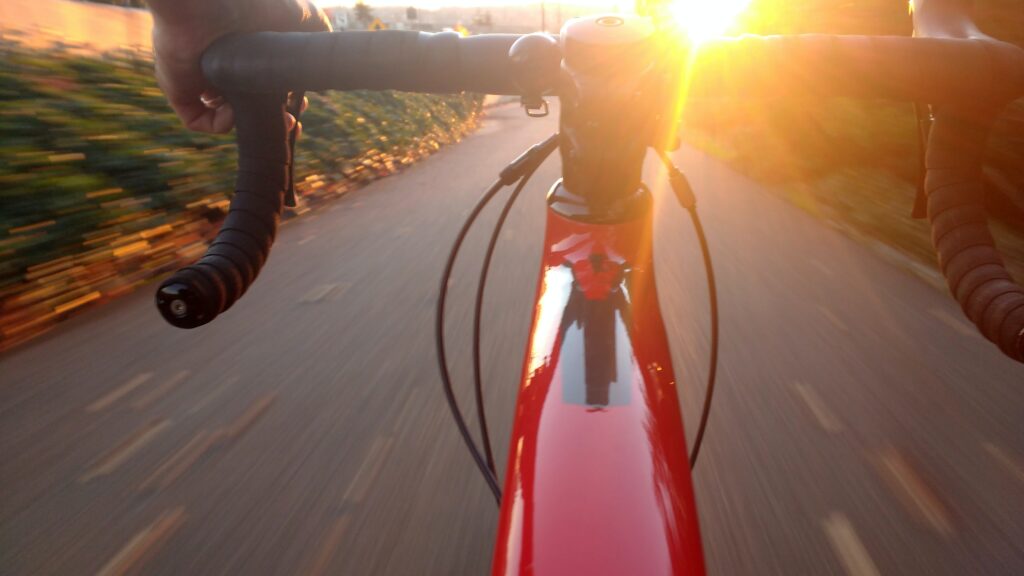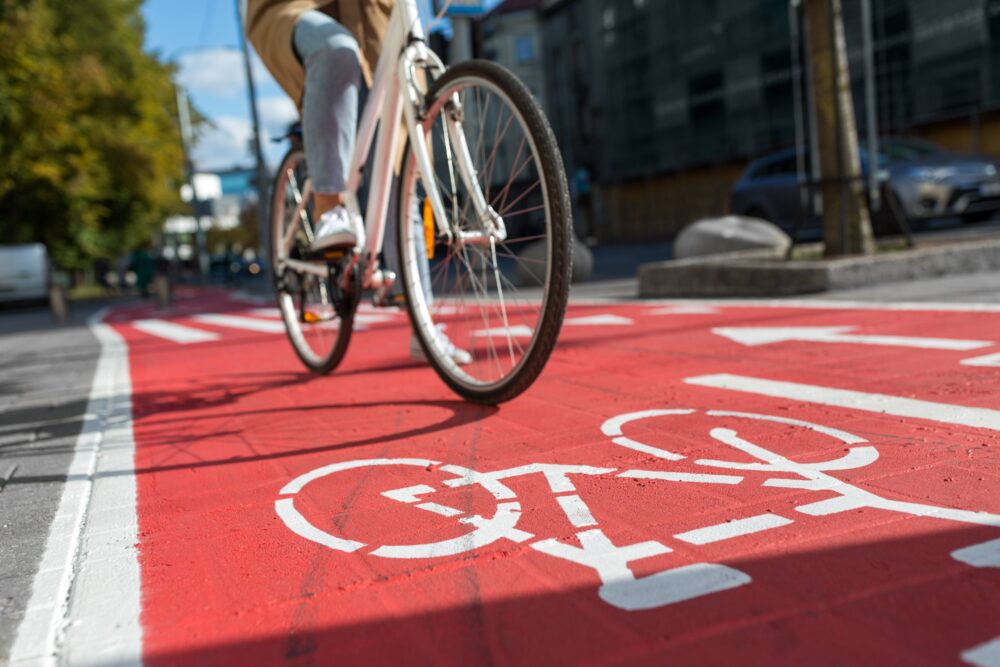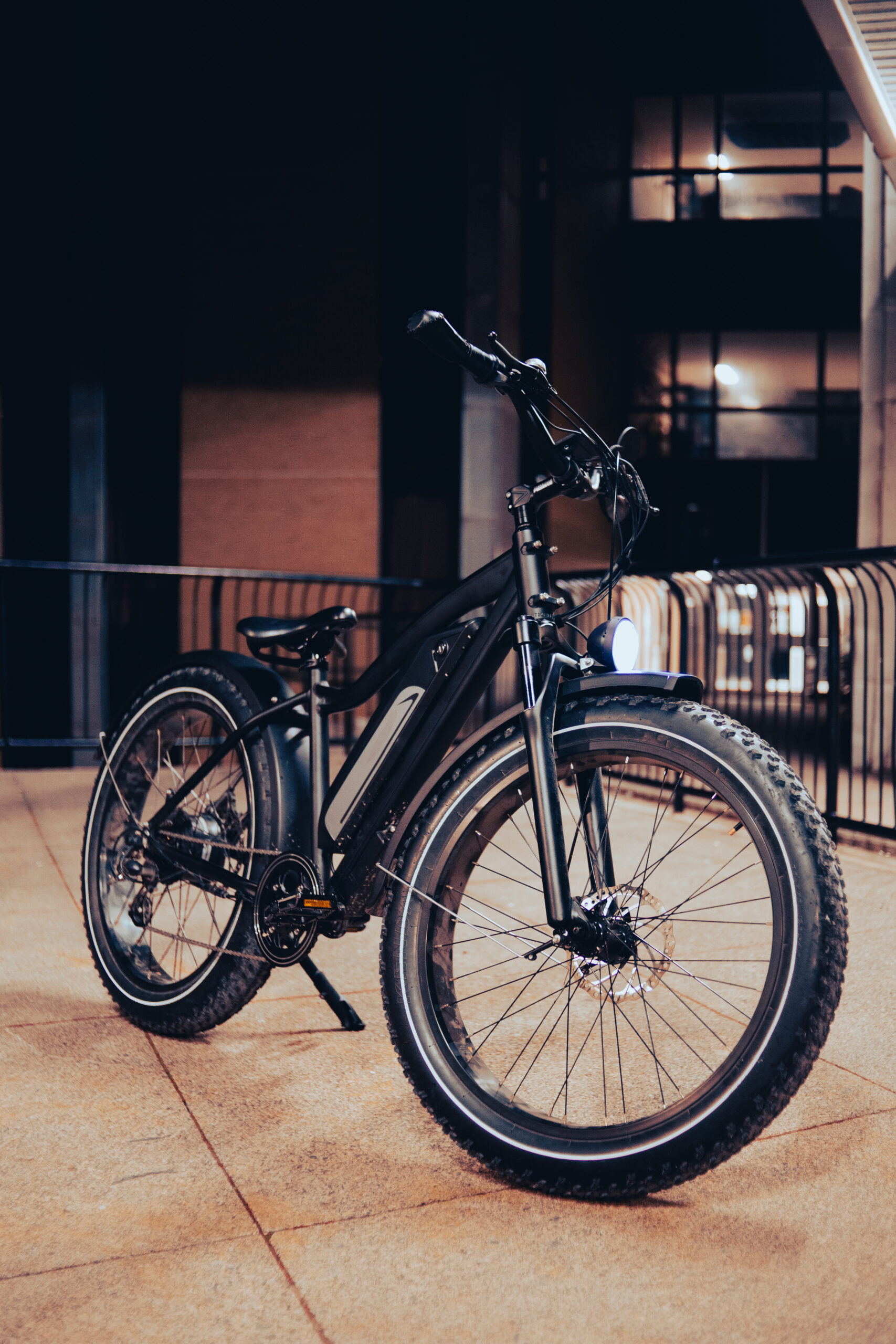
Bicycling, also referred to as biking or cycling, is a form of transportation and a popular leisure-time physical activity. Health benefits include improved cardiovascular fitness, stronger muscles, greater coordination and general mobility, and reduced body fat. As with other types of exercise, it can also help improve mental health by lowering stress levels and stimulating feel-good endorphins.
Although not listed as an independent category in the American College of Sports Medicine’s annual top fitness trends, bicycling can be included in several of their top categories: outdoor activities, exercise for weight loss, group training (i.e., spinning classes), and fitness programs for older adults. [1] Bicycling is versatile—you can ride alone or with a group, indoors on a stationary bicycle or outdoors in nature, and at any age. It is a low-impact activity that reduces stress on the hips, knees, and feet and may be performed by people who cannot do higher-impact activities such as jogging or running.
Bicycling for transportation, such as commuting to work, provides the benefits of incorporating exercise into everyday life, reducing costs associated with driving a car or taking public transportation, and lessening road congestion and air/noise pollution, as seen in urban areas. [2] In one survey of cyclists, 21% reported biking to work. [3] Studies show that people who bike to work are more likely to meet national physical activity guidelines. Due to the intensity and energy expenditure of cycling, they are also more likely to meet recommended guidelines for cardiovascular fitness and health benefits. [3]
Bicycling and Health
Much research on the health benefits of bicycling focuses on “active commuting” which entails walking or cycling to work or other places that usually involve driving. These studies find that cycling reduces the risk of cardiovascular disease, diabetes, and early deaths, and may prevent weight gain or obesity. Most of the research is observational or cross-sectional, using self-reported surveys of cycling frequency. A possible bias in these studies is that cycling requires a minimum level of existing physical fitness, so adults who are healthier at baseline may be more likely to choose cycling or active commuting than less healthy individuals, which may affect mortality and disease rates. [4]
Bicycling Safety
A major reason people may not participate in biking is a belief that it is unsafe, which is not unfounded. [15] Bicycle riders in the U.S. have much higher fatality and serious injury rates than in comparable high-income countries. [16] According to the Centers for Disease Control and Prevention, about 1,000 bicyclists die in the U.S. each year in crashes involving motor vehicles, and more than 130,000 are injured on roads. [17] Male adults ages 55-69 are most likely to die from bicycle deaths, whereas male adolescents and young adults have the highest bicycle-related injuries. Deaths tend to occur in urban areas where there is heavier motor vehicle traffic; high speeds (of bicyclists and car drivers) and alcohol are major risk factors for accidents.
Moving toward a better bicycling environment
 Bicycling provides health and environmental benefits, but injury risk and safety remain a top deterrent. Fortunately, efforts are underway in many cities to improve bicycling infrastructure, including the building of cycle tracks or protected bike lanes. These facilities, located between sidewalks and the road, provide pedestrians, cyclists, and automobiles their own separate spaces to travel.
Bicycling provides health and environmental benefits, but injury risk and safety remain a top deterrent. Fortunately, efforts are underway in many cities to improve bicycling infrastructure, including the building of cycle tracks or protected bike lanes. These facilities, located between sidewalks and the road, provide pedestrians, cyclists, and automobiles their own separate spaces to travel.
Before 2011, no studies had been conducted in North America to show that cycle tracks, common in the Netherlands or Denmark, were safer than biking in the road with cars. This changed after a study in Montreal, Canada, revealed that cycle tracks had a 28% lower injury rate and attracted 2.5 times as many bicyclists compared to parallel roads without these bicycle facilities. [18] Additional research on 19 cycle tracks in the U.S. also found a lower risk of bicycle-vehicle than published crashes on roadways. [19] In Boston, Massachusetts, over a seven-year period with the initiation of its “Boston Bikes” program, newly constructed bicycle lanes, improved bicycle signage and parking, and a new bike share program led to a reduction in cycling injuries and an increase in people cycling. [20]
Beyond cycle tracks, some countries including the Netherlands and Denmark have implemented traffic signals for bicycles, special precautions at traffic intersections, and even express superhighways for cyclists riding longer distances to work. [16] Providing additional motorist training and traffic safety education in schools can further reduce accidents. Amenities along bike lanes such as bike-specific signals, smooth surfaces with low resistance, parks, sidewalk cafes, art, and trees planted between the lanes and street may attract more people to cycle. [21]
Still, financial and other challenges exist in creating bike-friendly environments. In the U.S., government funding is primarily for infrastructure that benefits motorized vehicles, leaving communities and businesses to fund their own bicycle infrastructure. [21] Indeed, there also remains a resistance from “car culture” to relinquish road space (including roadside parking spaces) to bikes, and criticism often arises when vehicles are constantly observed on roadways while cyclists may only appear sporadically on bike-dedicated infrastructure. However, rather than considering drivers “losing” and bicyclists “winning,” a win-win might be found in creative solutions that enhance the overall streetscape. For example, building a sidewalk-level cycle track reduces the need for painted lines, additional signs, cobra head lights that light the road, or plastic delineator posts. A raised, wide cycle track can also be built on a foundation that supports tree roots as well as a grass strip between the track and sidewalk to lessen the urban heat island effect. [22] Soft and low LED lighting can be an attractive edge to the road and, by shining on the pedestrians and bicyclists, show the human scale to a community. [23]
Rules of the road
Both cyclists and car drivers should be aware of cycling rules on the road. Check with your local state and municipal biking laws. Below are examples of common regulations.
- Cyclists are allowed on any public roads and sidewalks unless specifically prohibited, such as on express state highways or private roads. Ride in the direction of traffic.
- Cyclists must obey automobile road rules such as stopping at red lights and stop signs. Slow down at traffic intersections even if a light is green. An exception is that cyclists can pass cars on the right side.
- Cyclists may ride on sidewalks outside business districts but must yield to pedestrians and signal when passing, such as with a bell or horn.
- In certain states, cyclists must use hand signals when turning unless it is dangerous to remove hands from handlebars. At least one hand should be kept on the handlebars at all times. Learn more about using hand signals from the National Highway Traffic Safety Administration.
- Cyclists 16 years or younger must wear a helmet with chin strap meeting the U.S. Consumer Product Safety Commission requirements. This protects against brain and head injuries. An exception is if a child is riding with an adult in an enclosed trailer. Regardless of requirements, use of helmets by riders of all ages can substantially reduce risk of brain injuries.
- Bikes may be parked on sidewalks, but never blocking crosswalks, bus stops, fire hydrants, parking spaces, or walking access by pedestrians. Allow four feet clearance.
- Theft of bikes or biking equipment is very common, so take with you any parts that can be easily removed from the bike. Ideally lock the bike lock to a bike rack with a lock that secures the frame and wheels, such as with U-locks. Do not lock bikes to trees, handrails, or private fences.
- Some states require bike lights and reflectors for night use, and this is highly desirable even if not required. Display a white light on the front of the bicycle and a red light or reflector on the back. Wear ankle reflectors if the pedals do not have reflectors.
- Be alert at all times for pedestrians, cars, other cyclists, animals, and changes in the road terrain.
What Are E-Bikes?
 E-bikes are electric bicycles that consist of a small electric motor that operates when pedaling or by turning on a switch on the handlebar. Unlike a scooter that is completely motorized, riders must pedal using an e-bike, though the work effort is much less than with a traditional bicycle. A major benefit of an e-bike is the extra power provided when riding hills or if the biker fatigues after a certain distance; this feature can allow for a longer bike ride and different types of terrain. E-bikes typically travel up to 20 miles per hour, which is close to the average speed of an amateur cyclist on flat roads traveling about 17 miles per hour. Some states classify e-bikes in the same category as scooters or mopeds and have regulations on different types of roadways, but most states now allow e-bikes on the same roads as traditional bikes. E-bikes are popular with consumers who choose to bicycle to work over driving a car; this can save on weekly car expenses such as for parking and fuel as well as reduce hassles with traffic. The average cost is about $1000-2000 more than a traditional bicycle.
E-bikes are electric bicycles that consist of a small electric motor that operates when pedaling or by turning on a switch on the handlebar. Unlike a scooter that is completely motorized, riders must pedal using an e-bike, though the work effort is much less than with a traditional bicycle. A major benefit of an e-bike is the extra power provided when riding hills or if the biker fatigues after a certain distance; this feature can allow for a longer bike ride and different types of terrain. E-bikes typically travel up to 20 miles per hour, which is close to the average speed of an amateur cyclist on flat roads traveling about 17 miles per hour. Some states classify e-bikes in the same category as scooters or mopeds and have regulations on different types of roadways, but most states now allow e-bikes on the same roads as traditional bikes. E-bikes are popular with consumers who choose to bicycle to work over driving a car; this can save on weekly car expenses such as for parking and fuel as well as reduce hassles with traffic. The average cost is about $1000-2000 more than a traditional bicycle.
Regarding safety, some international studies report increased injuries related to e-bikes compared with conventional bicycles and which are more likely to require hospitalization. These more serious injuries may be likely due to the greater speed and weight of many e-bikes. [24,25] In the U.S., a study using data from the U.S. National Electronic Injury Surveillance System found that most e-bike injuries occurred in men (as was the case with bicycles) and, compared with standard bikes, e-bike injuries were twice as likely to involve a collision with a motor vehicle and three times more likely to involve a collision with a pedestrian. [26] Other studies have found that head trauma accidents involving e-bikes tended to involve older adult riders, which may be due to slower reaction times and less control with the e-bike. [25] Therefore bike helmets may be an important safety precaution. States have differing rules about wearing helmets when using e-bikes, most of which are age-dependent, but some also specify the type of e-bike. Check with your state’s bicycling regulations, but use of helmets is to be encouraged regardless of requirements because they can substantially reduce the risk of brain injury. Because e-bikes will not provide the same health benefits as traditional cycling and are associated with similar or increased risks from crashes, their use is best limited to situations where traditional bicycle riding is not a reasonable option.
Related
- Staying Active
- Walking for Exercise
- HIIT (High Intensity Interval Training)
- Yoga for Exercise
- Zumba Fitness
Last reviewed December 2022

